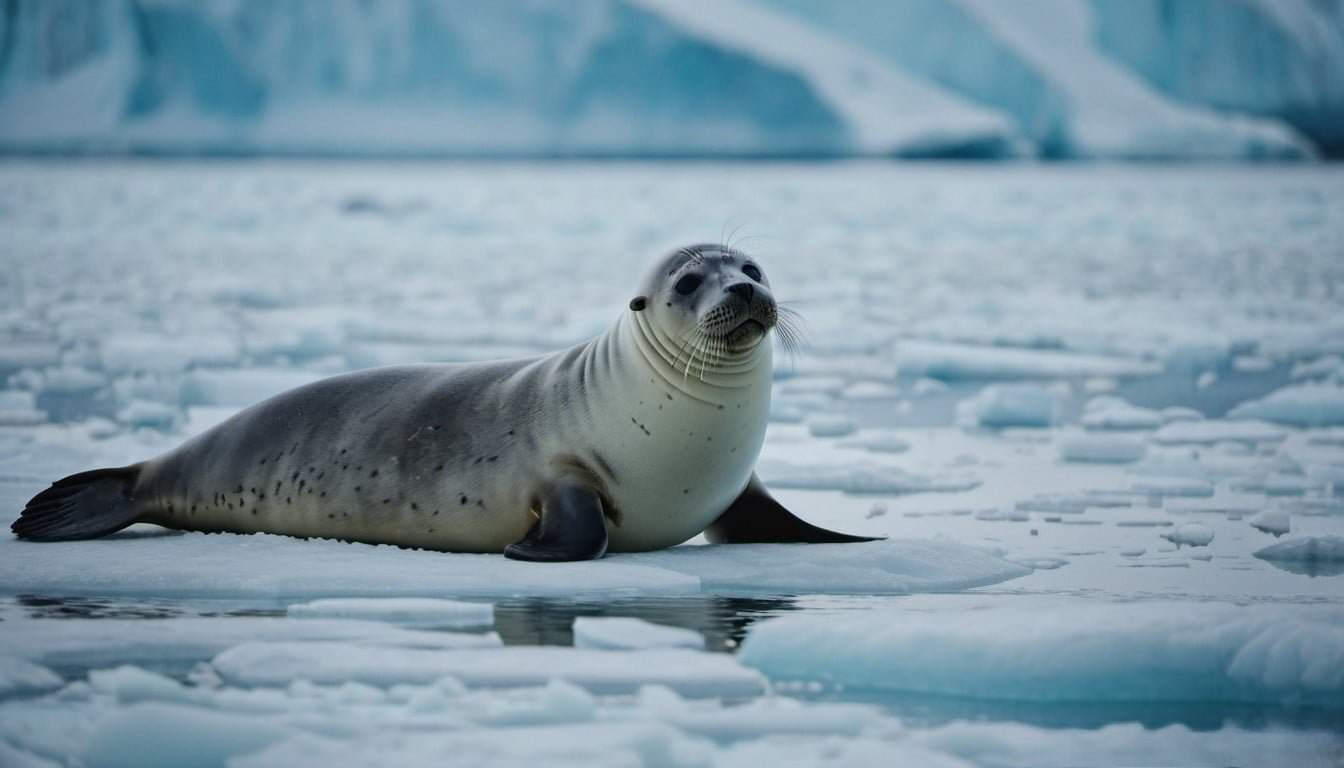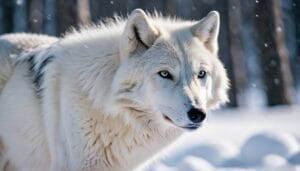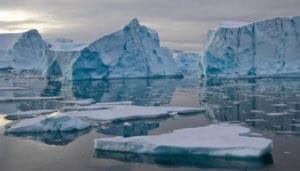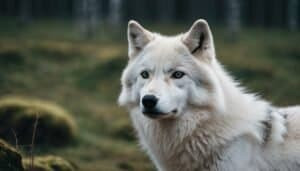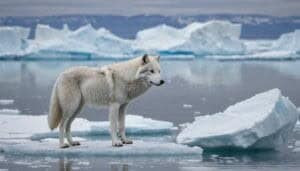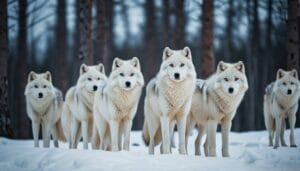Introduction
The reduction of sea ice in the Arctic is having profound effects on the region’s wildlife, particularly on Arctic wolf prey species like seals
This article explores how the loss of sea ice impacts the delicate balance of the Arctic ecosystem, affecting seal populations and, consequently, the survival of Arctic wolves. Additionally, we will examine the broader ecological and climatic impacts, and discuss current conservation efforts and future prospects for Arctic wildlife
The Impact of Sea Ice Reduction on Arctic Wolf Prey
The reduction of sea ice in the Arctic is a critical issue affecting numerous species, including the Arctic wolf and its primary prey, seals. Sea ice plays a vital role in maintaining the ecological balance in the Arctic, and its loss has far-reaching consequences
The Role of Sea Ice in the Arctic Ecosystem
Sea ice is more than just frozen water; it is a crucial component of the Arctic ecosystem. It provides a habitat for many species, supports unique microbial communities, and influences global weather patterns. For seals, sea ice serves as a platform for resting, breeding, and escaping predators
The presence of sea ice ensures that seals have safe places to give birth and nurse their pups, which is essential for maintaining their populations
The formation and persistence of sea ice also impact the availability of food. Many marine species rely on the ice for foraging, as it affects the distribution of plankton and other small organisms that are foundational to the Arctic food web
Consequently, the health of seal populations is directly tied to the presence of stable sea ice
Effects of Sea Ice Reduction on Seal Populations
The reduction of sea ice poses a significant threat to seal populations. As the ice diminishes, seals lose their primary habitat
They struggle to find suitable places to rest and breed, which leads to lower birth rates and higher mortality among pups. Without the ice as a safe haven, seals become more vulnerable to predators and environmental stresses
Furthermore, the loss of sea ice alters the distribution of prey for seals. The reduction in ice cover affects the abundance and availability of fish and other marine organisms that seals feed on. This can lead to nutritional stress and decreased body condition, making it harder for seals to survive and reproduce
Dependence of Arctic Wolves on Seals for Food
Arctic wolves are highly dependent on seals for their diet, especially during the harsh winter months when other prey is scarce
The availability of seals directly influences the health and survival of Arctic wolf populations. Wolves rely on seals not only for sustenance but also for the energy required to withstand the extreme cold of the Arctic environment
When seal populations decline due to the loss of sea ice, Arctic wolves face food shortages. This can lead to increased competition among wolves and other predators, forcing them to travel greater distances and expend more energy in search of food
The decreased availability of seals can also result in lower reproductive success and higher mortality rates among Arctic wolves
Influence of Sea Ice Loss on Arctic Wolf Hunting Behavior
The reduction of sea ice has profound effects on the hunting behavior of Arctic wolves. Traditionally, wolves hunt seals by waiting near breathing holes in the ice or by stalking them on the ice surface
With less ice available, these hunting strategies become less effective. Wolves may have to adapt by targeting different prey or changing their hunting tactics
The increased difficulty in finding and capturing seals can lead to malnutrition and weakened physical condition in wolves. This, in turn, affects their ability to reproduce and raise their young
The loss of sea ice forces Arctic wolves to expend more energy in their search for food, which can have cascading effects on their overall health and survival
Broader Ecological and Climatic Impacts
The reduction of sea ice in the Arctic extends beyond its immediate impact on seals and Arctic wolves. This loss has far-reaching ecological and climatic consequences that affect the entire region and even the global environment
Broader Ecological Impacts of Sea Ice Reduction
The decline in sea ice disrupts the intricate balance of the Arctic ecosystem. Many species, including polar bears, walruses, and various bird species, rely on sea ice for breeding, foraging, and protection
As the ice recedes, these species face habitat loss, leading to population declines and increased competition for the remaining resources
The reduction of sea ice also affects the marine food web. Phytoplankton, the base of the marine food chain, thrive under the ice. With less ice, there is a decrease in phytoplankton productivity, which ripples up the food chain, impacting fish, seals, and ultimately, Arctic wolves
The reduction in sea ice thus has a cascading effect, disrupting the entire ecosystem and leading to a decline in biodiversity
Climate Change Drivers of Sea Ice Loss
Climate change is the primary driver of sea ice reduction in the Arctic. Rising global temperatures, driven by increased greenhouse gas emissions, lead to the melting of ice at unprecedented rates
The Arctic is warming at more than twice the global average, a phenomenon known as Arctic amplification. This rapid warming accelerates ice melt and reduces the extent and thickness of sea ice
Additionally, feedback mechanisms exacerbate ice loss. As ice melts, it exposes darker ocean water, which absorbs more solar radiation compared to the reflective ice. This further warms the water, leading to more ice melt in a self-reinforcing cycle
This feedback loop contributes significantly to the ongoing reduction in sea ice
Projections for Future Sea Ice Levels
Future projections for sea ice levels are alarming. Climate models predict that the Arctic could experience ice-free summers within the next few decades if current trends continue. This would have devastating consequences for Arctic wildlife and the broader global climate system
The loss of sea ice also has implications for global weather patterns. The Arctic acts as a refrigerator for the Earth, and the reduction in sea ice affects the jet stream, leading to more extreme weather events in the northern hemisphere
These changes underscore the urgency of addressing climate change to mitigate the impacts on sea ice and the broader environment
Conservation Efforts and Future Outlook for Arctic Wildlife
Efforts to mitigate the impact of sea ice reduction on Arctic wildlife are crucial for preserving these ecosystems. Conservation strategies aim to protect critical habitats, address climate change, and ensure the survival of species such as seals and Arctic wolves
Current Conservation Strategies
Several conservation initiatives focus on protecting the Arctic environment and its inhabitants. International agreements, such as the Arctic Council, bring together Arctic nations to coordinate efforts in addressing climate change and its impacts
These efforts include monitoring sea ice levels, studying wildlife populations, and implementing measures to reduce greenhouse gas emissions
Marine protected areas (MPAs) are another key strategy. These designated areas restrict human activities, such as commercial fishing and oil drilling, to protect critical habitats and allow ecosystems to recover. By preserving regions where sea ice is most likely to persist, MPAs provide refuges for species that depend on ice, such as seals and Arctic wolves
Additionally, conservation organizations work on the ground to support wildlife. This includes rescue and rehabilitation programs for injured or stranded animals, as well as community-based initiatives that involve local populations in conservation efforts
Education and awareness campaigns also play a vital role in highlighting the importance of the Arctic and the need to protect it
Potential Future Measures
Looking ahead, more aggressive measures may be needed to address the ongoing loss of sea ice and its impacts. These could include stronger international commitments to reduce greenhouse gas emissions and slow global warming
Enhanced cooperation between countries and stakeholders will be crucial to implementing effective climate policies and ensuring the protection of the Arctic environment
Technological advancements may also offer new solutions. For instance, geoengineering techniques, such as reflective particles to enhance ice reflectivity or artificial ice creation, are being explored. However, these methods come with significant risks and ethical considerations, requiring thorough evaluation before implementation
Furthermore, increased investment in research is essential. Understanding the complex interactions within the Arctic ecosystem and predicting future changes will help inform conservation strategies. This includes studying the resilience of species to adapt to changing conditions and identifying key areas that need protection
Long-Term Outlook for Arctic Ecosystems
The long-term outlook for Arctic ecosystems hinges on the global community’s ability to address climate change and implement effective conservation measures. While the current trajectory is concerning, there is still hope if concerted efforts are made to reduce emissions and protect critical habitats
Protecting the Arctic requires a multifaceted approach, involving international cooperation, innovative technologies, and robust conservation programs
By prioritizing the health of Arctic ecosystems, we can ensure the survival of species like seals and Arctic wolves and preserve the unique environment of the Arctic for future generations
The continued loss of sea ice presents significant challenges, but with dedicated efforts and a commitment to sustainability, it is possible to mitigate some of the impacts and support the resilience of Arctic wildlife
Conclusion
The reduction of sea ice in the Arctic profoundly impacts the region’s ecosystem, particularly affecting Arctic wolves and their primary prey, seals. Sea ice is essential for seals, providing a habitat for resting, breeding, and protection from predators
As sea ice diminishes, seal populations face habitat loss and increased vulnerability, leading to nutritional stress and lower birth rates. This directly affects Arctic wolves, which rely heavily on seals for food. The loss of sea ice forces wolves to adapt their hunting strategies and expend more energy in search of food, impacting their overall health and survival
Broader ecological and climatic impacts are also significant. The reduction in sea ice disrupts the Arctic food web, affecting various species and leading to a decline in biodiversity
Climate change, driven by increased greenhouse gas emissions, is the primary cause of sea ice loss, creating feedback loops that accelerate the process. Projections for future sea ice levels are alarming, with potential ice-free summers in the coming decades, further emphasizing the urgency of addressing climate change
Conservation efforts are vital in mitigating these impacts. Current strategies include international agreements, marine protected areas, and on-the-ground conservation initiatives
Future measures may involve stronger international commitments, technological advancements, and increased investment in research. The long-term outlook for Arctic ecosystems depends on the global community’s ability to address climate change and implement effective conservation measures
Protecting the Arctic requires a multifaceted approach, prioritizing the health of ecosystems and ensuring the survival of species like seals and Arctic wolves. With dedicated efforts and a commitment to sustainability, it is possible to mitigate some of the impacts of sea ice reduction and support the resilience of Arctic wildlife
